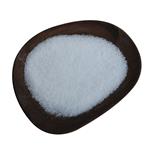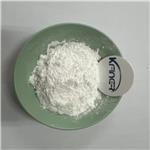Chemical Properties
white crystals or crystalline powder
Uses
Glycine hydrochloride is an inhibitory neurotransmitter in spinal cord, allosteric regulator of NMDA receptors.Glycine Hydrochloride is commonly used in buffer solutions, in electrophoresis, and preparative chromatography.
Preparation
Glycine hydrochloride can be prepared by the action of hydrochloric acid on hippuric acid,aminoacetonitrile,methyleneaminoacetonitrile, and on ethyl phthaliminoacetate. Aniline has been recommended for its conversion into free glycine. Glycine can also be prepared by the interaction of chloroacetic acid and ammonia; by the hydrolysis of methyleneaminoacetonitrile by successive treatments with barium hydroxide and sulfuric acid; and by the hydrolysis of aminoacetonitrile by means of barium hydroxide. A thorough study has been reported for its preparation in improved yields by the sulfuric acid hydrolysis of aminoacetonitrile, and in satisfactory yields from chloroacetic acid and ammonia. Other methods of preparation include the reduction of cyanoformic esters, a modified Curtius degradation of ethyl cyanoacetate, and the hydrolysis of the neck ligaments of cattle.
synthesis of Glycine hydrochloride
Application
Glycine hydrochloride has been used as a component of Ag (silver)-stripping buffer for multiplex immunohistochemistry in mice tissues.
Glycine hydrochloride has been used:
in the preparation of glycine-HCl buffer
to elute serum immunoglobulins (IgGs) from the beads in order to check for the complete enrichment of core- and site-specific antibodies
to regenerate the sensor to elute the bound C-reactive protein (CRP)
Definition
Glycine hydrochloride is a non-essential amino acid. It is found primarily in gelatin and silk fibroin and used therapeutically as a nutrient. It is also a fast inhibitory neurotransmitter.
Flammability and Explosibility
Not classified
Biochem/physiol Actions
Glycine acts on receptors which bring out an enhanced chloride conductance. It shows highest concentrations in the spinal cord as compared to elsewhere in the brain. However, it interacts with and allostericaly activates the excitatory receptor N-methyl-D-aspartate (NMDA), thus, resulting in excitatory transmission in brain.
Glycine comprises a single carbon molecule, that is attached to the amino and a carboxyl group. Glycine hydrochloride (Gly·HCl) is capable of liquifying native chitosan and also helps in the preparation of regenerated chitosan membrane. It can serve as an osmoprotectant. Glycine can act as a flexible link in proteins and can also allow the formation of helices. Free glycine may have a protecting role in tissues against ischemia, hypoxia and reperfusion.
Inhibitory neurotransmitter in spinal cord, allosteric regulator of NMDA receptors.
Purification Methods
Crystallise the salt from absolute EtOH or 80% EtOH. Monoglycine hydrochloride has m 176-177o, and diglycine monohydrochloride has m 187o. [Frost J Am Chem Soc 64 1286 1942, Beilstein 4 III 1111, 4 IV 2353.]





